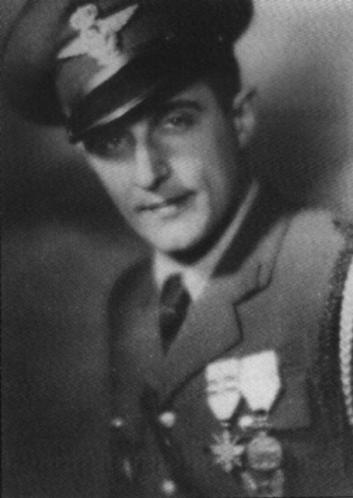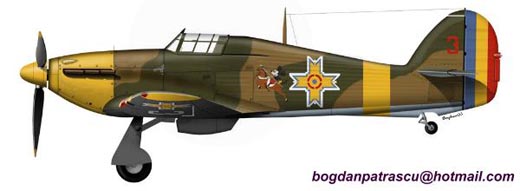I know we all like to know the history on the aircraft/pilots of the planes we are doing, so, here is the info I have found doing my research.
cpt. av. Horia Agarici
Fighter Pilot
Born: 6 April 1911, Lausanne
Units:
- 1941: 53rd Fighter Squadron
- 1942 - February 1943: 52nd Fighter Squadron
- February 1943 - August 1944: 7th Fighter Group
Combat missions: N/A
Victories: 10 victories + 2 probable
Decorations: N/A
Died: 13 July 1982, Constanta
Biography:

Picture from "Rumanian aces of World War 2" by Dénes Bernád, Osprey, 2004
Lt. av. Horia Agarici wearing the Virtutea Aerinautica Order Gold Cross class.
Horia Agarici was born on 6 April 1911 in Lausanne, Switzerland, where his family was during a business trip. He grew up in Iasi, being raised by his aunt. There he went to the elementary school and then continued high school in Pitesti, Brasov, only to return to Iasi, where he graduated in 1929. For one year he attended the courses of the Polytechnic Institute in Timisoara. In 1931 he was admitted in the Air Force Officer School in Bucharest, which he finished in 1933 and was assigned to the 1st Baloon Flotilla. At his request he was transferred to the Flight School in Tecuci. He graduated in 1934 and was sent to the bombers. In 1937 he went to the Fighter School at Buzau and then he was assigned to the 1st Fighter Flotilla.
In the eve of the beginning of Operation Barbarossa, lt. av. Horia Agarici was part of the 53rd Fighter Squadron, based at Mamaia airfield, near Constanta, which had the mission to defend the Romanian coastline and the railroad bridge over the Danube against Soviet air attacks. It was the only Romanian unit equipped with the Hawker Hurricane Mk. I and it will distinguish itself in the air battles of 1941.
From the first day of the war, 22 June 1941, the Hurricanes claimed several kills over VVS fighters, while escorting formations of Romanian bombers that were attacking Soviet bases in southern Bessarabia. However, lt. av. Agarici wasn't among the victors. It was the following day that made him famous.
On 23 June 1941, the Hurricanes of the 53rd Fighter Squadron took off on an escort mission. After a while lt. av. Agarici returned to the airfield, because of a malfunction that caused oil to spill over his windscreen. He landed without problems and the mechanics started to work on the airplane. After a few minutes they heard engine roar coming from the sea. They saw three Soviet bombers heading towards Constanta, probably with the intention to bomb the harbor. Lt. av. Agarici immediately took off, although the problem on his Hurricane hadn't been solved. He quickly gained altitude to meet the DB-3s that were flying at about 2000 m. He then dived and attacked the formation leader. Soon after that the bomber caught fire and probably fell into the sea. He again gained altitude and attacked. A second DB-3 started to go down in flames. It dropped its bombs over the sea and crash-landed on Romanian soil. The crew was later taken prisoner. The third bomber had already turned back when lt. av. Horia Agarici reached it. He attacked and set it on fire. Another Soviet bomber formation appeared, but retreated after seeing what happened to the first one. Agarici came back to the airfield and landed. He did not know the result of the battle, because his windscreen was almost entirely covered with oil. Only two of the claims were confirmed. One remained probable.

Profile courtesy of Bogdan Patrascu
This Hurricane Mk. I was flown by lt. av. Horia Agarici in the 53rd Fighter Squadron during 1941
This action was transformed into a very popular song about Agarici and his victories, composed apparently that night at the party thrown for the ace in a restaurant in Constanta. The story was picked up by the Romanian propaganda and soon Agarici and his song became well known throughout Romania.
By the end of August 1941, lt. av. Horia Agarici had claimed another two aircraft shot down, of which one was a Yak-1, mistakenly identified as a Hurricane. Thus he achieved the ace status with five kills.
All the publicity and fame generated by the song and the propaganda service created him only problems, as he attracted the envy of other fighter pilots, who did not regard him as a very good pilot and soldier. His superiors did not usually qualify him as a good pilot, but a medium one. He was a more a poet, than a warrior. He even published a poetry volume during the war. Even Agarici himself was embarrassed by his fame. This made him loose his interest in the war and did not perform any more impressive feats until the end of the war.
In 1942 he was promoted to the rank of captain and received the command of the 52nd Fighter Squadron, which had replaced the 53rd on the Mamaia airfield. It was equipped with IAR-80 aircraft and usually provided air cover for the Axis convoys in the Black Sea. In early 1943 he was assigned to the 7th Fighter Group and received a administrative job as chief of the operations bureau.
In October 1943, the 7th Fighter Group returned to Romania for reorganization and refitting. Cpt. av. Horia Agarici was assigned to the 58th Fighter Squadron, with which he took part in the fights with the US 15th Air Force in the spring of 1944. During the first American raid over Romania that year, on 4 April 1944, cpt. Agarici claimed a B-24, while flying the IAR-80C no. 381. His aircraft was also damaged and he had to make a crash landing at Epuresti. It was his last kill.
After the war ended and the Communists gained the power, he was obviously thrown out of the army and stripped of his rank. He was however reinstated as captain later, but his life was marked by the wartime fame and he suffered because of it until his death on 13 July 1982 at Constanta, the city he defended that day in June 1941.